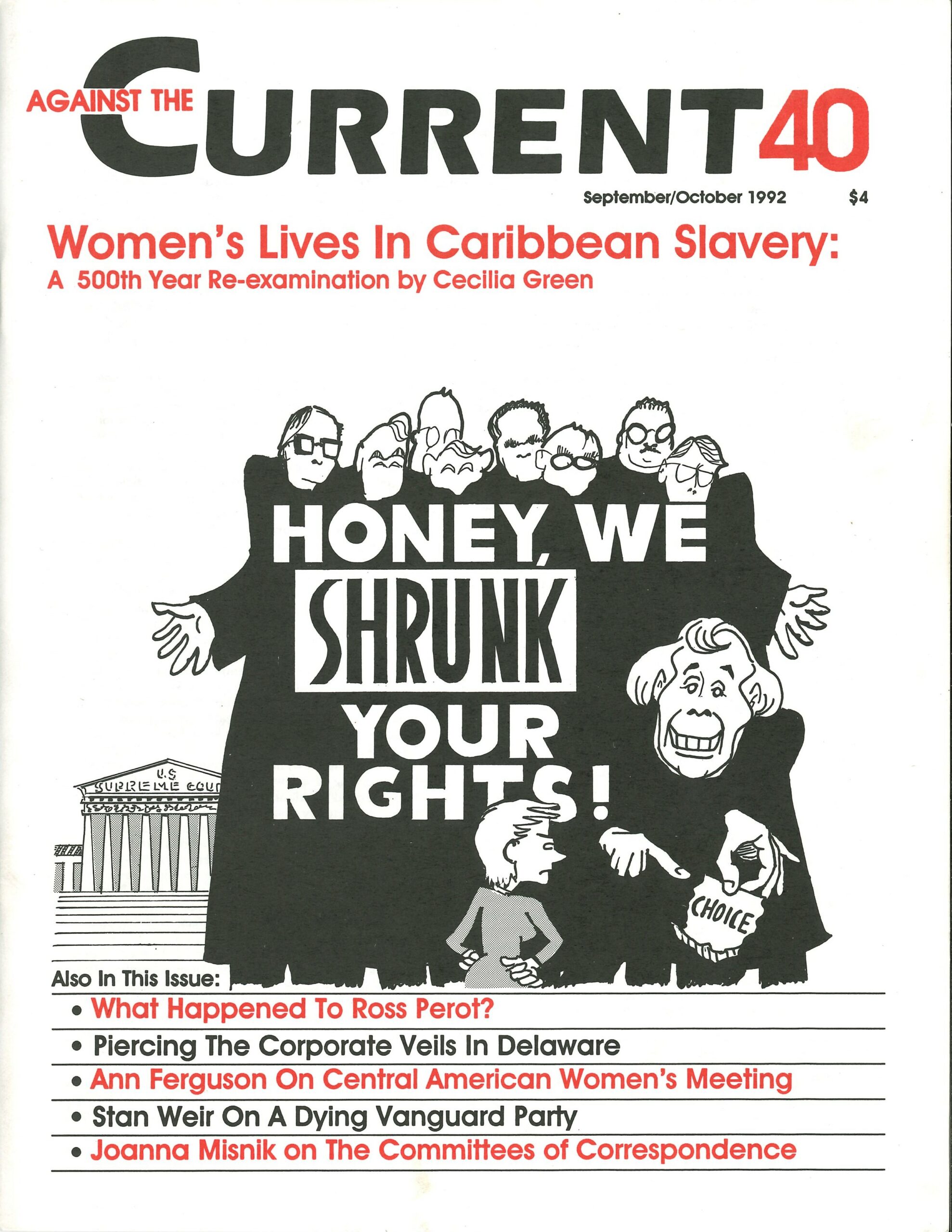Against the Current, No. 40, September/October 1992
-
No More Compromise!
— The Editors -
The Great Lesser-Evil Illusion
— Justin Schwartz -
Ross Perot for ...? Never Mind
— Steven Ashby -
Committee of Correspondence Looking Ahead
— Joanna Misnik -
LA After the Explosion: Rebellion and Beyond
— Joe Hicks, Antonio Villaralgosa & Angela Oh -
Gender & Re/Production in British West Indian Slave Societies, Part I
— Cecilia Green -
Greece Under the Conservatives
— James Petras and Chronis Polychroniou -
Panama: Crackdown Follows Anti-Bush Protests
— The Empowerment Project -
Israeli Elections: Who Won?
— Marcello Wechsler -
Palestine: Of War and Shadows
— Josie Wallenius -
Gender in the Revolution
— Ann Ferguson -
The Rebel Girl: The Pussy's Revenge
— Catherine Sameh -
A Brief Historical Background
— Stan Weir -
1956: The Fading Revolution
— Stan Weir -
Poverty Amidst Plenty in 1992
— Robert Hornstein and Daniel Atkins -
Oh for the Good Old Days
— R.F. Kampfer - Reviews
-
The Sixties Remembered
— Patrick M. Quinn -
Women of the Klan
— David Futrelle -
Reform and Revolution
— Samuel Farber - In Memoriam
-
Phil Clark, 1921-1992
— Patrick M. Quinn
Catherine Sameh
IMAGINE MY SURPRISE to find that Batman Returns is a film as much about corporate greed, urban decay and the oppressed getting revenge as it Is about the glorified violence of superheroes. Much of the focus in this sequel to Batman is on Catwoman, and in spite of all the press about Michell Pfleffer’s sex appeal, I want to draw attention to the femmist aspects of the film.
Catwoman emerges when Selina Kyle, a working-class secretary, is murdered by her boss, a rich factory owner who dumps toxic waste into the sewers of Gotham City. She has tried repeatedly to get respect from this male-dominated workplace, but instead has been constantly patronized and humiliated. When she discovers extremely compromising information about her boss’s pet project, he pushes her out his twenty-story building. Moments later, as cats swarm around her dad body, Selina comes back to life—as Catwoman.
In the next scene, one of the most delightful in the film, we watch a stunned Selina return to her apartment, realizing what has happened to her. She explodes with rage and begins covering her very pink apartment with black spray paint. She then begins to madly sew a Catwoman costume from a black leather outfit she has, completing her transformation from an abused secretary to a very pissed off Catwoman.
Catwoman is out for revenge—on the man who killed her and other men who get in her way. In one scene, Cat-woman prances around in a store, destroying things around her, thrilled with her new power. Two cops stop dead in their tracks when they see her. “I don’t know whether to fall in love or shoot,’ one cop says to the other. “You poor guys,” Catwoman purrs. “Always confusing your pistols for your privates.” She sends them running.
Batman also gets in Catwoman’s way. He doesn’t so much do anything to her, as get in the way of her merry revenge making. She sees him as competition, as another man who wants to prove his superiority—and she is bound to show him otherwise. Like Thelma and Louise, Catwoman sees every man as a target for her anger. “Life’s a bitch, so I became one,” she explains, capturing the feeling most women have about their anger at a society that fucks them over.
Like Batman, Catwoman is a divided self, ordinary person and masked super-hero at once. In the end, when they stop fighting, Batman is ready to merge his selves, to remove his mask and become whole. In a closing scene, when Catwoman/Selina Kyle finally confronts her boss, Batman/Bruce Wayne urges her to “just turn him in,” to go through legal, judicial channels. He wants her to “come home” with him, for they are “two halves of the same whole, split down the middle.” But Selina/Catwoman is still trying to figure out this new part of herself, not ready to abandon her newfound strength and anger for the security of romance and wealth. She kills her boss and tells Batman, “I would love to live with you in your mansion, but this is not a happy ending.” No easy resolutions here. Catwoman risks a life of solitude, so that she may understand and utilize the anger that gives her power.
Batman Returns is a violent and cynical film for sure. And unlike Thelma and Louise, there is no female solidarity in the film, except for when Catwoman rescues a woman from rape (unfortunately, by a man of color). This is not our ideal feminist movie, but rather a conscious expression of women’s anger at men—violent, surreal, and fantastical, but reflecting a palpable current in this society, slamming against the tide of sexism.
September-October 1992, ATC 40

